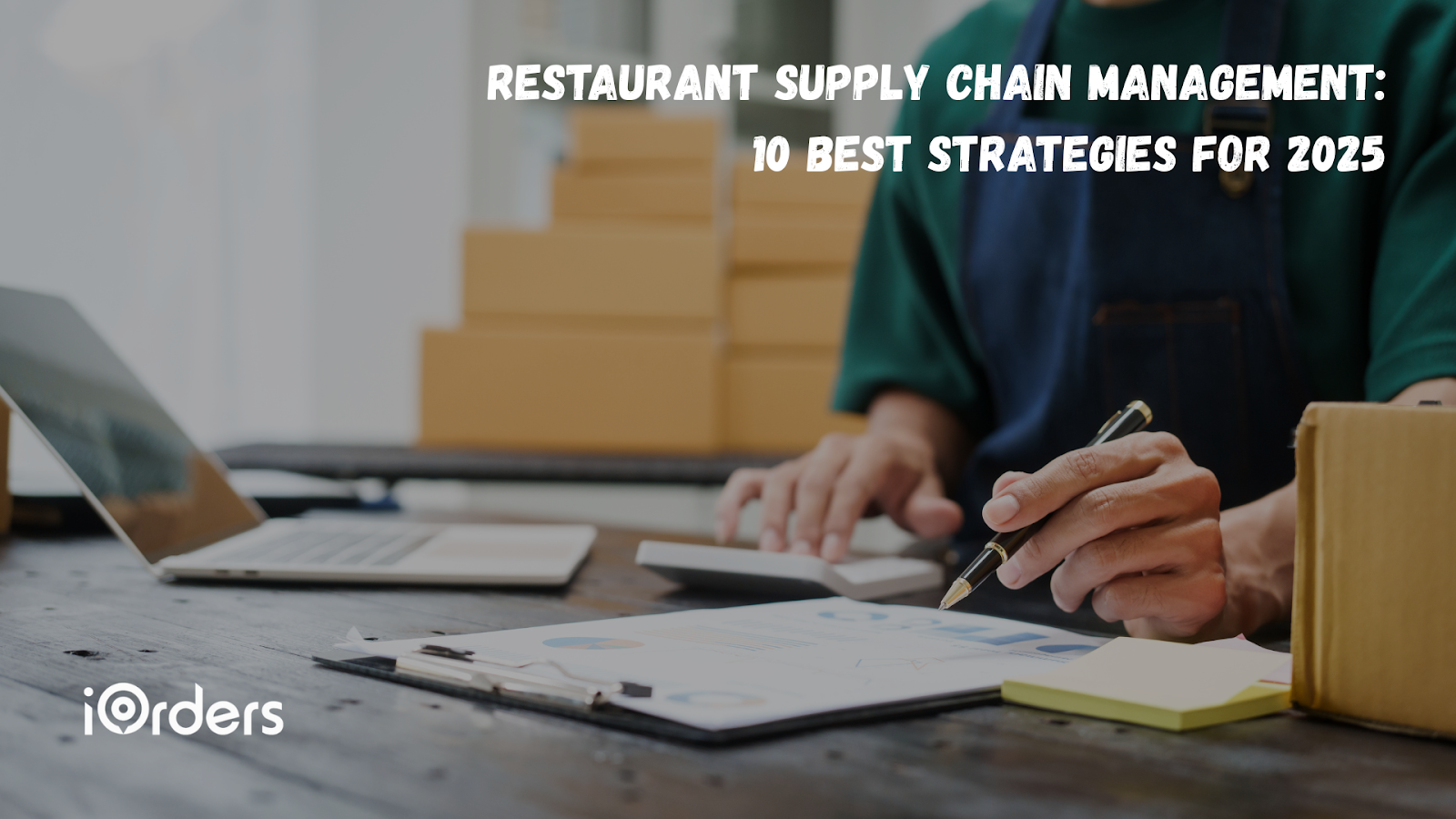July 25, 2025

Are delivery delays and ingredient shortages squeezing your margins?
In 2025, managing your restaurant supply chain well can be the difference between profit and loss. Canada’s foodservice sector is predicted to reach $135.5 billion by 2033. But inflation, global disruptions, and local labor issues threaten restaurants’ supply chains, impacting timely deliveries and pricing.
Even with resilient networks across the country, restaurants face rising ingredient costs, unpredictable logistics, and tighter profit margins. To address these challenges, a forward-looking restaurant supply chain plan is essential.
In this guide, you will learn practical, proven strategies used by top-performing restaurants to future-proof your supply chain and maintain smooth operations. Whether you run a café, a cloud kitchen, or a full-service spot, this guide shows how to protect your restaurant from supply chain crises and position it for steady growth.

While every food journey starts from farm to fork, your restaurant's supply chain encompasses far more. It's a dynamic, integrated system that goes beyond simple ingredient delivery. It intricately manages every step from how you source ingredients, to their storage, the preparation of meals in your kitchen, and the ultimate delivery or service to your guests.
This unique process integrates real-time inventory use, precise kitchen operations, and daily customer interaction, creating an immediate and direct link to your customers' dining experience.
Effective restaurant supply chain management is crucial for success, offering numerous benefits:
A strong restaurant supply chain keeps your kitchen stocked, costs under control, and quality consistent. It ensures fresh supplies arrive on time and supports your long-term growth. Without effective management, you risk delays, wastage, and unhappy guests.
The following are the key components of the restaurant supply chain:
This unique chain integrates procurement, real-time preparation, and direct service to your customers, all under one roof.
Also Read: 15 Strategies to Maximize Restaurant Delivery Sales
Strong supply management builds resilience against shortages and market changes. But there come rigid challenges that can disrupt your restaurant’s supply chain flow and profit goals.

Managing your restaurant supply chain isn’t easy. You deal with rising prices, changing customer demands, and supplier uncertainties, all while trying to serve fresh meals daily. Each challenge impacts your cost, quality, and reputation.
Here are the main challenges to address:
Also Read: Best Restaurant Inventory Tracking Software of 2025
Managing these challenges with a clear strategy is important. Next, let’s learn about proven restaurant supply chain strategies to keep your kitchen running profitably and efficiently.

Supply chain issues can impact your cost, quality, and daily operations. But with the right restaurant supply chain strategies, you can overcome these challenges and build a stable, future-ready kitchen.
Here are 10 practical and proven strategies to keep your restaurant running profitably:
Your suppliers are partners in your success. Build long-term relationships to secure better pricing, priority deliveries, and consistent quality. Visit them in person, share feedback, and discuss forecasts to align goals. Diversify suppliers to reduce risks from sudden shortages.
For example, have two produce vendors for critical items like greens and tomatoes. This way, if one fails, your kitchen operations don’t stop. Good supplier relations also help negotiate better payment terms, easing cash flow pressures in tough months.
Just-in-Time (JIT) means ordering supplies as needed rather than bulk-stocking. It reduces wastage, maintains food freshness, and lowers holding costs.
For example, order dairy twice weekly instead of weekly to keep it fresh and reduce spoilage. However, it requires reliable suppliers and accurate sales forecasting. Combine JIT with safety stock for fast-moving or essential items.
This strategy keeps your inventory lean and improves kitchen workflow as staff handle fewer expired or damaged items daily.
Digital tools help track inventory, supplier orders, and deliveries in real time. POS-integrated inventory systems update stock levels as you sell items. It prevents over-ordering or stockouts. Some software also alerts you when an item runs low, auto-generating purchase orders to save staff time.
Real-time tracking helps avoid last-minute shortages that could disrupt service. It also provides data on wastage trends so you can adjust portion sizes or supplier orders to boost profit.
Also Read: Innovative Types of Restaurant Technology Trends for 2025
Buying local and seasonal ingredients reduces transport costs and supports your community. Guests love fresh, local produce, and it builds brand loyalty.
For example, source strawberries from nearby farms in summer instead of importing. Seasonal menus aligned with local harvests also reduce supply costs and environmental impact. Build direct partnerships with farmers or local distributors to ensure a reliable supply.
This strategy makes your menu stand out while keeping your restaurant supply chain flexible and cost-effective.
Customers are now conscious of eco-friendly dining. Switching to biodegradable or reusable packaging can improve brand perception and meet upcoming regulations.
For example, replace plastic takeaway containers with compostable options. Train staff to reduce single-use items and food waste. Sustainable practices attract new guests and lower waste disposal costs.
Work with suppliers who use minimal packaging and eco-friendly logistics for an end-to-end sustainable supply chain approach.
Use your POS and sales data to predict demand patterns. Look at past weeks, seasons, and events to forecast orders.
For example, if Fridays sees 30% more pizza sales, increase dough prep and toppings stock accordingly. Data-driven forecasting reduces overstocking and wastage while ensuring you never run out of popular items. It also improves vendor communication as you can place accurate, timely orders based on clear data insights rather than guesswork.
iOrders’ Smart AI-powered Review System makes this easier. It tells you exactly how guests feel and which operational areas affect their experience. Engage with all reviews in one place to spot trends and adjust supply orders based on true demand. Forecast smarter to keep guests happy and inventory costs low.
Your staff handles receiving, storing, prepping, and recording inventory daily. Training them ensures proper stock rotation, accurate receiving counts, and safe storage.
For example, train kitchen staff on FIFO (First In, First Out) to reduce spoilage. Regular training also improves the reporting of damaged or low-stock items. Well-trained teams minimize wastage, reduce errors, and maintain compliance during health inspections, protecting your margins and reputation.
Don’t accept supplier contracts as final. Negotiate for flexible payment schedules, bulk discounts, or delivery timing that matches your kitchen prep cycles.
For example, ask for net-30 payment terms instead of upfront payments to ease cash flow. Or negotiate split deliveries to keep stock fresh without extra fees. Regular reviews and renegotiation of contracts ensure you keep costs competitive and adapt terms as your business grows.
Cloud kitchens focus only on delivery and takeout, reducing rent and utility costs compared to dine-in outlets. They centralize prep and production, allowing you to serve multiple brands from one kitchen. It streamlines your supply chain by consolidating inventory and vendor management under one roof.
For example, run a pizza and wings brand from the same space using the same suppliers and staff, doubling revenue without doubling expenses.
Also Read: Cloud Kitchen Opening Process for Beginners in 2025
Audit your entire supply chain process quarterly. Check supplier performance, delivery timelines, stock wastage, and storage conditions. It helps identify hidden leaks in your system.
For example, if audits show repeated delays from a produce vendor, consider switching suppliers or changing delivery schedules. Regular audits ensure your restaurant supply chain remains efficient, cost-effective, and aligned with your goals.
These strategies will help build a resilient supply chain that grows with your restaurant’s goals. Now, let’s understand some common supply chain mistakes that cost restaurants money and guest trust daily.

Running a smooth restaurant supply chain means spotting gaps before they become problems. Many owners overlook basics that cost them money and customer trust.
Here are the top mistakes, why they affect you, and how to avoid them:
Small mistakes build fast in the supply chain. Now, let’s see how iOrders helps you manage your restaurant supply chain efficiently and confidently.
Managing your restaurant supply chain also means reducing operational inefficiencies at ordering and customer touchpoints. iOrders helps you handle this side efficiently.
iOrders doesn’t directly manage your supply chain, but it optimizes the order-to-fulfilment journey, letting you focus on quality sourcing and kitchen management.
Running a restaurant today means managing rising food costs, supplier issues, and inventory waste while keeping quality high. Strong supply chain practices help you stay efficient, reduce wastage, and serve your guests better every day.
Common challenges like supplier delays and rising costs, and strategies such as diversifying suppliers, real-time inventory tracking, and data-based demand forecasting can protect your margins.
Want to simplify ordering, grow your brand online, and improve guest experience without third-party commissions? iOrders helps you own your online ordering, manage digital menus, and build customer loyalty seamlessly.
Ready to improve your restaurant supply chain management? Book a free demo with iOrders today.
Implement just-in-time purchasing and audit inventory regularly. Forecast demand using sales and POS data to avoid over-ordering perishable items. Regular staff training also ensures proper storage and rotation. These steps cut waste and lower costs.
Relying on a single supplier can disrupt operations if they delay or fail. Working with multiple vendors ensures backup options and better pricing. It also supports consistent ingredient quality by reducing dependency on one source.
Digital systems integrate POS with inventory tracking, automate reordering, and forecast demand using sales data. These tools reduce manual errors, prevent stockouts, and help maintain quality and freshness.
Yes. Local and seasonal purchasing lowers transport costs and meets customer demand for eco-friendly options. It also allows you to market transparency, boosting brand loyalty even if ingredient prices rise.
Delays, wrong orders, or expired stock hurt menu availability, slow service, and damage guest trust. Strong operational systems, from ordering to delivery, help you meet guest expectations consistently.